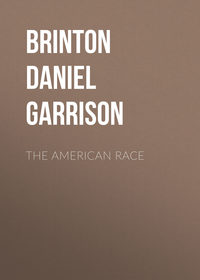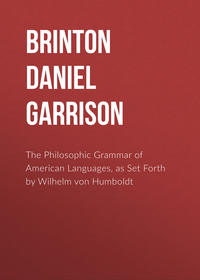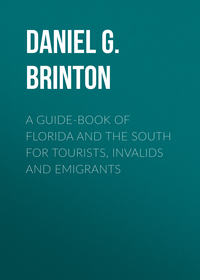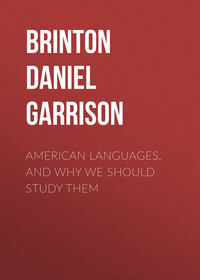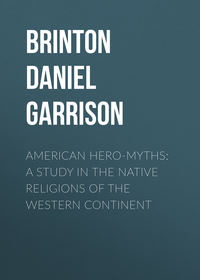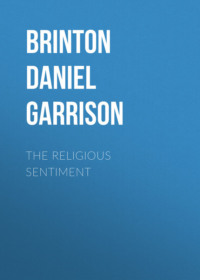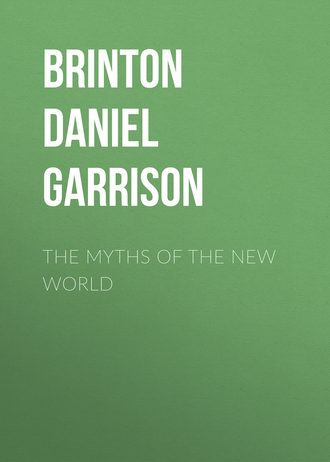 полная версия
полная версияThe Myths of the New World
309
See the dissertation of Prof. Nève referred to above.
310
American State Papers, Indian Affairs, i. p. 729. Date of legend, 1801.
311
Molina, Hist. of Chili, ii. p. 82.
312
Richardson, Arctic Expedition, p. 239.
313
Dumont, Mems. Hist. sur la Louisiane, i. p. 163.
314
Schoolcraft, Ind. Tribes, v. p. 686.
315
Desjardins, Le Pérou avant la Conq. Espagn., p. 27.
316
Cod. Chimalpopoca, in Brasseur, Hist. du Mexique, Pièces Justificatives.
317
These four birds, whose names have lost their signification, represent doubtless the four winds, or the four rivers, which, as in so many legends, are the active agents in overwhelming the world in its great crises.
318
The word rendered mill-stone, in the original means those large hollowed stones on which the women were accustomed to bruise the maize. The imitative sounds for which I have substituted others in English, are in Quiché, holi, holi, huqui, huqui.
319
Brasseur translates “quoique nous ne sentissions rien,” but Ximenes, “nos quemasteis, y sentimos el dolor.” As far as I can make out the original, it is the negative conditional as I have given it in the text.
320
Le Livre Sacré, p. 27; Ximenes, Or. de los Indios, p. 13.
321
The American nations among whom a distinct and well-authenticated myth of the deluge was found are as follows: Athapascas, Algonkins, Iroquois, Cherokees, Chikasaws, Caddos, Natchez, Dakotas, Apaches, Navajos, Mandans, Pueblo Indians, Aztecs, Mixtecs, Zapotecs, Tlascalans, Mechoacans, Toltecs, Nahuas, Mayas, Quiches, Haitians, natives of Darien and Popoyan, Muyscas, Quichuas, Tuppinambas, Achaguas, Araucanians, and doubtless others. The article by M. de Charency in the Revue Américaine, Le Deluge, d’après les Traditions Indiennes de l’Amérique du Nord, contains some valuable extracts, but is marred by a lack of criticism of sources, and makes no attempt at analysis, nor offers for their existence a rational explanation.
322
Une Fête Brésilienne célébré à Rouen en 1550, par M. Ferdinand Denis, p. 82 (quoted in the Revue Américaine, ii. p. 317). The native words in this account guarantee its authenticity. In the Tupi language, tata means fire; parana, ocean; Monan, perhaps from monáne, to mingle, to temper, as the potter the clay (Dias, Diccionario da Lingua Tupy: Lipsia, 1858). Irin monge may be an old form from mongat-iron, to set in order, to restore, to improve (Martius, Beiträge zur Ethnographie und Sprachenkunde Amerika’s, ii. p. 70).
323
Professor Nève, ubi supra, from the Zatapatha Brahmana.
324
Avendano, Sermones, Lima, 1648, in Rivero and Tschudi, Peruv. Antiqs., p. 114. In the year 1600, Oñate found on the coast of California a tribe whose idol held in one hand a shell containing three eggs, in the other an ear of maize, while before it was placed a cup of water. Vizcaino, who visited the same people a few years afterwards, mentions that they kept in their temples tame ravens, and looked upon them as sacred birds (Torquemada, Mon. Ind., lib. v. cap. 40 in Waitz). Thus, in all parts of the continent do we find the bird, as a symbol of the clouds, associated with the rains and the harvests.
325
The deluge was called hun yecil, which, according to Cogolludo, means the inundation of the trees, for all the forests were swept away (Hist. de Yucathan, lib. iv. cap. 5). Bishop Landa adds, to substantiate the legend, that all the woods of the peninsula appear as if they had been planted at one time, and that to look at them one would say they had been trimmed with scissors (Rel. de las Cosas de Yucatan, 58, 60).
326
Vues des Cordillères, p. 202.
327
Ubi sup., p. 207.
328
The Scandinavians believed the universe had been destroyed nine times:—
Ni Verdener yeg husker,Og ni Himle,says the Voluspa (i. 2, in Klee, Le Deluge, p. 220). I observe some English writers have supposed from these lines that the Northmen believed in the existence of nine abodes for the blessed. Such is not the sense of the original.
329
At least this is the doctrine of one of the Shastas. The race, it teaches, has been destroyed four times; first by water, secondly by winds, thirdly the earth swallowed them, and lastly fire consumed them (Sepp., Heidenthum und Christenthum, i. p. 191).
330
Echevarria y Veitia, Hist. de la Nueva España, lib. i. cap. 4, in Waitz.
331
Brasseur, Hist. du Mexique, iii. p. 495.
332
The contrary has indeed been inferred from such expressions of the writer of the book of Ecclesiastes as, “that which hath been, is now, and that which is to be, hath already been” (chap. iii. 15), and the like, but they are susceptible of an application entirely subjective.
333
Voluspa, xiv. 51, in Klee, Le Deluge.
334
Natur. Quæstiones, iii. cap. 27.
335
Velasco, Hist. du Royaume du Quito, p. 105; Navarrete, Viages, iii. p. 444.
336
Rel. de la Nouv. France, An 1637, p. 54; Schoolcraft, Ind. Tribes, i. p. 319, iv. p. 420.
337
Schoolcraft, ibid., iv. p. 240.
338
Cogolludo, Hist. de Yucathan, lib. iv. cap. 7.
339
The Spanish of Lizana is—
“En la ultima edad, segun esta determinado,Avra fin el culto de dioses vanos;Y el mundo sera purificado con fuego.El que esto viere sera llamado dichosoSi con dolor lloraré sus pecados.”(Hist. de Nuestra Señora de Itzamal, in Brasseur, Hist. du Mexique, ii. p. 603). I have attempted to obtain a more literal rendering from the original Maya, but have not been successful.
340
Vocabulario Quiche, s. v., ed. Brasseur, Paris, 1862.
341
The Eskimo innuk, man, means also a possessor or owner; the yelk of an egg; and the pus of an abscess (Egede, Nachrichten von Grönland, p. 106). From it is derived innuwok, to live, life. Probably innuk also means the semen masculinum, and in its identification with pus, may not there be the solution of that strange riddle which in so many myths of the West Indies and Central America makes the first of men to be “the purulent one?” (See ante, p. 135.)
342
Müller, Amer. Urrelig., pp. 109, 229.
343
D’Orbigny, Frag. d’une Voy. dans l’Amér. Mérid., p. 512. It is still a mooted point whence Shakspeare drew the plot of The Tempest. The coincidence mentioned in the text between some parts of it and South American mythology does not stand alone. Caliban, the savage and brutish native of the island, is undoubtedly the word Carib, often spelt Caribani, and Calibani in older writers; and his “dam’s god Setebos” was the supreme divinity of the Patagonians when first visited by Magellan. (Pigafetta, Viaggio intorno al Globo, Germ. Trans.: Gotha, 1801, p. 247.)
344
Both Lederer and John Bartram assign it this meaning. Gallatin gives in the Powhatan dialect the word for mountain as pomottinke, doubtless another form of the same.
345
Marcy, Exploration of the Red River, p. 69.
346
Compare Romans, Hist. of Florida, pp. 58, 71; Adair, Hist. of the North Am. Indians, p. 195; and Gregg, Commerce of the Prairies, ii. p. 235. The description of the mound is by Major Heart, in the Trans. of the Am. Philos. Soc., iii. p. 216. (1st series.)
347
The French writers give for Great Spirit coyocopchill; Gallatin for hill, kweya koopsel. The blending of these two ideas, at first sight so remote, is easily enough explained when we remember that on “the hill of heaven” in all religions is placed the throne of the mightiest of existences. The Natchez word can be analyzed as follows: sel, sil, or chill, great; cop, a termination very frequent in their language, apparently signifying existence; kweya, coyo, for kue ya, from the Maya kue, god; the great living God. The Tarahumara language of Sonora offers an almost parallel instance. In it regui, is above, up, over, reguiki, heaven, reguiguiki, a hill or mountain (Buschmann, Spuren der Aztek. Sprache im nörd. Mexico, p. 244). In the Quiché dialects tepeu is lord, ruler, and is often applied to the Supreme Being. With some probability Brasseur derives it from the Aztec tepetl, mountain (Hist. du Mexique, i. p. 106).
348
Balboa, Hist. du Pérou, p. 4.
349
Long’s Expedition to the Rocky Mountains, i. p. 274; Catlin’s Letters, i. p. 178.
350
Richardson, Arctic Expedition, pp. 239, 247; Klemm, Culturgeschichte der Menschheit, ii. p. 316.
351
Long, Exped. to the Rocky Mountains, i. p. 326.
352
Schoolcraft, Ind. Tribes, v. p. 683.
353
Schwarz, Ursprung der Mythologie, p. 121.
354
Journal Historique, p. 351: Paris, 1740.
355
Rep. of the Commissioner of Ind. Affairs, 1854, pp. 211, 212. The old woman is once more a personification of the water and the moon.
356
Bægert, Acc. of the Aborig. Tribes of the Californian Peninsula, translated by Chas. Rau, in Ann. Rep. Smithson. Inst., 1866, p. 387.
357
Of the Nicaraguans Oviedo says: “Ce n’est pas leur cœur qui va en haut, mais ce qui les faisait vivre; c’est-à-dire, le souffle qui leur sort par la bouche, et que l’on nomme Julio” (Hist. du Nicaragua, p. 36). The word should be yulia, kindred with yoli, to live. (Buschmann, Uber die Aztekischen Ortsnamen, p. 765.) In the Aztec and cognate languages we have already seen that ehecatl means both wind, soul, and shadow (Buschmann, Spuren der Aztek. Spr. in Nördlichen Mexico, p. 74).
358
Rel. de la Nouv. France, An 1636, p. 104; “Keating’s Narrative,” i. pp. 232, 410.
359
French, Hist. Colls. of Louisiana, iii. p. 26.
360
Mrs. Eastman, Legends of the Sioux, p. 129.
361
Voy. à la Louisiane fait en 1720, p. 155: Paris, 1768.
362
Dupratz, Hist. of Louisiana, ii. p. 219; Dumont, Mems. Hist. sur la Louisiane, i. chap. 26.
363
Rel. de la Prov. de Cueba, p. 140.
364
Coreal, Voiages aux Indes Occidentales, ii. p. 94: Amsterdam, 1722.
365
Senate Rep. on the Ind. Tribes, p. 358: Wash. 1867.
366
Egede, Nachrichten von Grönland, p. 145.
367
Alger, Hist. of the Doctrine of a Future Life, p. 76.
368
Hawkins, Sketch of the Creek Country, p. 80.
369
Rel. de la Nouv. France, 1634, pp. 17, 18.
370
Müller, Amer. Urreligionen, p. 229.
371
La Vega, Hist. des Incas., lib. ii. cap. 7.
372
Ueber die Ureinwohner von Peru, p. 41.
373
Coreal, Voy. aux Indes Occident., i. p. 224; Müller, Amer. Urrelig., p. 289.
374
Oviedo, Hist. du Nicaragua, p. 22.
375
Torquemada, Monarquia Indiana, lib. vi. cap. 27.
376
Sahagun, Hist. de la Nueva España, lib. x. cap. 29.
377
Rel. de la Nouv. France, 1636, p. 105.
378
Molina, Hist. of Chili, ii. p. 81, and others in Waitz, Anthropologie, iii. p. 197.
379
Nachrichten von Grönland aus dem Tagebuche vom Bischof Paul Egede, p. 104: Kopenhagen, 1790.
380
Rel. de la Nouv. France, 1636, p. 105.
381
Long’s Expedition, i. p. 280; Waitz, Anthropologie, iii. p. 531.
382
Müller, Amer. Urreligionen, p. 287.
383
Compare Garcilasso de la Vega, Hist. des Incas., liv. ii. chap. ii., with Lett. sur les Superstitions du Pérou, p. 104. Çupay is undoubtedly a personal form from Çupan, a shadow. (See Holguin, Vocab. de la Lengua Quichua, p. 80: Cuzco, 1608.)
384
“El que desparece ô desvanece,” Hist. de Yucathan, lib. iv. cap. 7.
385
Ximenes, Vocab. Quiché, p. 224. The attempt of the Abbé Brasseur to make of Xibalba an ancient kingdom of renown with Palenque as its capital, is so utterly unsupported and wildly hypothetical, as to justify the humorous flings which have so often been cast at antiquaries.
386
Scheol is from a Hebrew word, signifying to dig, to hide in the earth. Hades signifies the unseen world. Hell Jacob Grimm derives from hilan, to conceal in the earth, and it is cognate with hole and hollow.
387
Pennock, Religion of the Northmen, p. 148.
388
La Hontan, Voy. dans l’Am. Sept., i. p. 232; Narrative of Oceola Nikkanoche, p. 75.
389
Morse, Rep. on the Ind. Tribes, App. p. 345.
390
Garcia, Or. de los Indios, lib. iv. cap. 26, p. 310.
391
Voiages aux Indes Oc., ii. p. 132.
392
Lettres Edif. et Cur., v. p. 203.
393
Alger, Hist. of the Doctrine of a Future Life, p. 72.
394
Loskiel, Ges. der Miss. der evang. Brüder, p. 49.
395
Richardson, Arctic Expedition, p. 260.
396
Gumilla, Hist. del Orinoco, i. pp. 199, 202, 204.
397
Ruis, Conquista Espiritual del Paraguay, p. 48, in Lafitau.
398
Notes on the Floridian Peninsula, pp. 191 sqq.
399
Bruyas, Rad. Verborum Iroquæorum.
400
Buschmann, Athapask. Sprachstamm, pp. 182, 188.
401
Torquemada, Monarquia Indiana, lib. vi. cap. 41.
402
Le Livre Sacré des Quichés, pp. 175-177.
403
Müller, Amer. Urrelig., p. 290, after Spix.
404
D’Orbigny, Annuaire des Voyages, 1845, p. 77.
405
Long’s Expedition, i. p. 278.
406
Hist. des Incas, lib. iii. chap. 7.
407
Hist. of the New World, bk. v. chap. 7.
408
Travels in North America, p. 280.
409
Egede, Nachrichten von Grönland, p. 156.
410
Haeser, Geschichte der Medicin, pp. 4, 7: Jena, 1845.
411
Schoolcraft, Ind. Tribes, v. p. 440.
412
Carver, Travels in North America, p. 73: Boston, 1802; Narrative of John Tanner, p. 135.
413
Sahagun, Hist. de la Nueva España, lib. x. cap. 20; Le Livre Sacré des Quichés, p. 177; Lett. sur les Superstit. du Pérou, pp. 89, 91.
414
Life of Black Hawk, p. 13.
415
Travs. in North America, p. 74.
416
Journal Historique, p. 362.
417
Sometimes facts like this can be explained by the quickness of perception acquired by constant exposure to danger. The mind takes cognizance unconsciously of trifling incidents, the sum of which leads it to a conviction which the individual regards almost as an inspiration. This is the explanation of presentiments. But this does not apply to cases like that of Swedenborg, who described a conflagration going on at Stockholm, when he was at Gottenberg, three hundred miles away. Psychologists who scorn any method of studying the mind but through physiology, are at a loss in such cases, and take refuge in refusing them credence. Theologians call them inspirations either of devils or angels, as they happen to agree or disagree in religious views with the person experiencing them. True science reserves its opinion until further observation enlightens it.
418
Schoolcraft, Indian Tribes, iii. p. 287; v. p. 652.
419
“The progress from deepest ignorance to highest enlightenment,” remarks Herbert Spencer in his Social Statics, “is a progress from entire unconsciousness of law, to the conviction that law is universal and inevitable.”
420
The Creeks had, according to Hawkins, not less than seven sacred plants; chief of them were the cassine yupon, called by botanists Ilex vomitoria, or Ilex cassina, of the natural order Aquifoliaceæ; and the blue flag, Iris versicolor, natural order Iridaceæ. The former is a powerful diuretic and mild emetic, and grows only near the sea. The latter is an active emeto-cathartic, and is abundant on swampy grounds throughout the Southern States. From it was formed the celebrated “black drink,” with which they opened their councils, and which served them in place of spirits.
421
Martius, Von dem Rechtzustande unter den Ureinwohnern Brasiliens, p. 32.
422
Mr. Anderson, in the Am. Hist. Mag., vii. p. 79.
423
Such spectacles were nothing uncommon. They are frequently mentioned in the Jesuit Relations, and they were the chief obstacles to missionary labor. In the debauches and excesses that excited these temporary manias, in the recklessness of life and property they fostered, and in their disastrous effects on mind and body, are depicted more than in any other one trait the thorough depravity of the race and its tendency to ruin. In the quaint words of one of the Catholic fathers, “If the old proverb is true that every man has a grain of madness in his composition, it must be confessed that this is a people where each has at least half an ounce” (De Quen, Rel. de la Nouv. France, 1656, p. 27). For the instance in the text see Rel. de la Nouv. France, An 1639, pp. 88-94.
424
Schoolcraft, Indian Tribes, v. p. 423.
425
J. M. Stanley, in the Smithsonian Miscellaneous Contributions, ii. p. 38.
426
D’Orbigny, L’Homme Américain, ii. p. 81.
427
See Balboa, Hist. du Pérou, pp. 28-30.
428
D’Orbigny, L’Homme Américain, ii. p. 235.
429
Schoolcraft, Ind. Tribes, v. p. 652.
430
Dr. Mac Gowan, in the Amer. Hist. Mag., x. p. 139; Whipple, Rep. on the Ind. Tribes, p. 35.
431
Hist. des Incas, lib. iii. ch. 22.
432
Travels in the Carolinas, p. 504.
433
Hist. du Pérou, p. 128; Voiages aux Indes Occidentales, ii. p. 97.
434
Beverly, Hist. de la Virginie, p. 266. The dialect he specifies is “celle d’Occaniches,” and on page 252 he says, “On dit que la langue universelle des Indiens de ces Quartiers est celle des Occaniches, quoiqu’ils ne soient qu’une petite Nation, depuis que les Anglois connoissent ce Pais; mais je ne sais pas la difference qui’l y a entre cette langue et celle des Algonkins.” (French trans., Orleans, 1707.) This is undoubtedly the same people that Johannes Lederer, a German traveller, visited in 1670, and calls Akenatzi. They dwelt on an island, in a branch of the Chowan River, the Sapona, or Deep River (Lederer’s Discovery of North America, in Harris, Voyages, p. 20). Thirty years later the English surveyor, Lawson, found them in the same spot, and speaks of them as the Acanechos (see Am. Hist. Mag., i. p. 163). Their totem was that of the serpent, and their name is not altogether unlike the Tuscarora name of this animal usquauhne. As the serpent was so widely a sacred animal, this gives Beverly’s remarks an unusual significance. It by no means follows from this name that they were of Iroquois descent. Lederer travelled with a Tuscarora (Iroquois) interpreter, who gave them their name in his own tongue. On the contrary, it is extremely probable that they were an Algonkin totem, which had the exclusive right to the priesthood.
435
Riggs, Gram. and Dict. of the Dakota, p. ix; Kane, Second Grinnell Expedition, ii. p. 127. Paul Egede gives a number of words and expressions in the dialect of the sorcerers, Nachrichten von Grönland, p. 122.
436
Waitz, Anthropologie der Naturvoelker, i. p. 459.
437
Navarrete, Viages, iii. p. 415.
438
Relation de Cueba, p. 140. Ed. Ternaux-Compans.
439
La Vega, Hist. des Incas, liv. v. cap. 12.
440
Morse, Rep. on the Ind. Tribes, App. p. 345.
441


